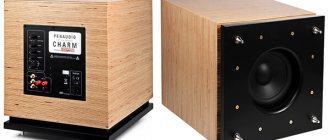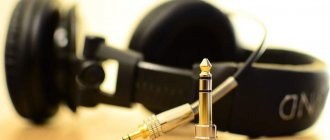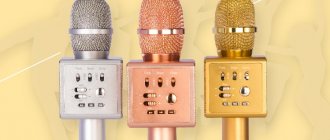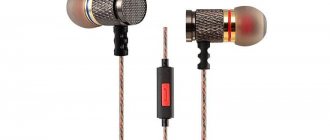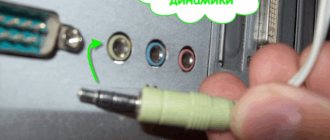What is the difference and what are the benefits of Hi-End players?
The dream that someday engineering will merge together and a single universal port will come to the world, which will be devoid of shortcomings and will be suitable for any purpose in any industry, remains a dream. Optical, coaxial, jack, S/PDIF... This variety makes your head spin. Today we will look at the main audio ports that are used in portable gadgets. Three premium brands that produce Hi-End players will help us with this: Astell&Kern , Colorfly and HiFiMan .
TRS jack connector
The TRS standard is one of the oldest and time-tested, since it was first used at the dawn of the design of telephone switches in the 19th century. Initially, the TRS connector had a simplified TS design (there was no additional ring channel). The essence of the abbreviation itself is as follows:
- T = tip – translated from English as “tip”;
- R = ring – translated from English as “ring”;
- S = sleeve – translated from English as “sleeve”;
The design of the TRS plug fully justifies its components: a pointed sleeve with plastic insulating partitions separating the channels. The generally accepted standard for a TRS plug and, accordingly, a port is a traditional stereo jack, which has three contacts: left and right channels + ground.
With the advent of smartphones, TRS has undergone minor changes, having received an additional ring responsible for a microphone headset ( TRRS ). Sony went the furthest, presenting a series of Xperia Z smartphones, the headset of which has a five-pin jack ( TRRRS ) on the two rings of which two microphones are powered: one for speech recording, the other for noise reduction.
There are three sizes of TRS audio connectors:
- 6.3 mm jack (1/4 inch). Used in professional musical equipment: from mixers and sound cards, to microphones and musical power instruments.
- 3.5 mm jack. A universal audio output that is used in consumer electronics and portable equipment of any level.
- 2.5 mm jack. A standard that is gradually becoming a thing of the past. Scope of application: portable equipment, tuners, headphone cup connection ports with detachable cords.
How to listen: Connecting via TRS is the simplest: it’s easy to choose the appropriate adapter for any size of port and plug, but the main enemy of cheapness remains physics. Don’t expect “super sound” and the laurels of “reference vinyl” from TRS.
The nuances of connecting headphones via USB
All headphones with a standard rectangular USB plug are equipped with their own sound card, which is necessary to convert the digital signal to analog. Therefore, when connecting them to computers, laptops and tablets with USB ports, you must also install the appropriate driver. In Windows 10 and 11, if you have access to the Internet, installation is almost always done automatically as soon as the headphone plug is connected to the computer. However, surround sound headsets are most often defined as two separate devices: headphones and a microphone.
There may be difficulties with Android OS if the headset has an advanced sound card. In addition, to connect you will need an OTG cable, which acts as an adapter between the USB plug and the micro-USB connector of a smartphone or tablet.
It is also worth mentioning the USB Type-C connector, which provides for the transmission of not only a digital signal, but also an analog one. There are headphones on sale with Type-C plugs that are ready to work with electromagnetic frequencies directly, but the devices to which they will be connected do not always have a built-in DAC. Therefore, it is better to purchase USB-C headsets with their own sound card.
Balanced output
In the field of professional audio equipment, one of the reference connection options is balanced . Externally, it is not much different from a wide-profile TRS, but its operating algorithm allows you to achieve noticeably better sound quality.
With an unbalanced connection (the usual jack/minijack used in smartphones and inexpensive players), the signal arrives through two conductors: ground and the information channel (left/right). This solution can significantly reduce the final cost of an audio device, but has one drawback - a high level of interference.
With a balanced connection (symmetrical), the signal passes through three conductors: two information channels (direct and reverse) and ground. Thus, the electrical impedance between the conductors is balanced because it is supplied in antiphase. The result: a significant increase in the power of the useful signal and minimization of interference.
How to listen: Shielding the cable against antiphase... The winner will definitely be the balanced connection version. Forget about interference, noise and distortion, but it's still physics.
Signal levels
Depending on the type, the cable can operate with a digital or analog signal. Analog has four levels.
Speaker level - signal level supplied to the speaker systems. This is the highest level in terms of applied voltage.
Line level — analog line level signal. Standard level +4 dBv and +10 dBv for household devices. Used to match audio system components when interconnect cables are used.
Instrument level — signal level from synthesizers, electric guitars and other electric musical instruments. To bring the signal to line level, you usually need a dibox.
Mic level - the weakest signal level coming from microphones. Preamplifiers in audio cards are needed precisely to amplify this level to linear.
Coaxial digital output S/PDIF. RCA and TOSLINK connector
As the recording industry has evolved, engineers have continued to be challenged on how to minimize acoustic distortion and interference. the coaxial was found . S – Sony company, P – Philips company, which took part in the development of this standard; DIF – digital interface (translated from English as “digital interface”).
The main feature of the coaxial digital output is that there is no need to convert sound from digital to analog, which allows you to maintain the original signal quality with the lowest possible level of loss.
The most popular digital output is considered to be RCA - “tulip”, created back in the 40s of the last century. Another option for implementing S/PDIF is an optical cable and TOSLINK , which converts an electrical signal into an optical one. The optical beam is then transmitted through the cable's shielded sheath. The peculiarity of optical signal transmission is that it is not susceptible to any electromagnetic interference. When arriving at the playback source, the optical signal is again converted into electrical.
How to listen: Optics requires a subtle approach and loves expensive accessories. Get ready to tinker with the selection of an original high-quality cable, but the result will be more than worth it. The option with a digital connection eliminates an extra round of transformations, which also has a positive effect on sound quality.
The older the model from the Korean manufacturer is in the class, the better it sounds. For Astell&Kern this is an axiom. From the simple Astell&Kern AK Jr model with a single jack, to the symbiosis of optics and TRS with an additional balanced input in the AK240 and AK380 models.
Astell&Kern AK380: TRS jack, optical 3.5 mm, balanced output (4-pin 2.5 mm, requires an amplifier);
Astell&Kern AK240: TRS jack, optical 3.5 mm, balanced output (4-pin 2.5 mm, requires an amplifier);
Astell&Kern AK120 II: TRS jack, optical 3.5 mm, balanced output (4-pin 2.5 mm, requires an amplifier);
Astell&Kern AK100 II: TRS jack, optical 3.5 mm, balanced output (4-pin 2.5 mm, requires an amplifier);
Astell&Kern AK Jr: TRS jack.
“Made in China” is a verdict on the quality as we are accustomed to perceive it when we see this inscription. When it comes to Hi-End, Chinese engineers cannot afford to do something bad. Players from Colorfly are distinguished by their stylish design and the presence of a good arsenal of ports (especially the Colorfly C4 Pro model).
Colorfly C4 Pro: 3.5 mm TRS jack and 6.3 mm TRS jack (work synchronously); S/PDIF.
Colorfly C10: TRS jack, balanced output (3.5 mm jack);
Colorfly C3: TRS jack.
A wide range of models from the American ]HiFiMAN[/anchor] allows you to choose a player to your taste, even if you are guided solely by its appearance. The original solution of the manufacturer is the presence of a switch from a regular to a balanced 3.5 mm TRS port.
HiFiMAN HM-901s: TRS jack, balanced output (3.5 mm jack);
HiFiMAN HM-901: TRS jack/balanced output (4-pin port, supplied with an adapter; switch provided);
HiFiMAN HM-802: TRS jack/balanced output (4-pin port, supplied with an adapter; switch provided);
HiFiMAN HM-700: TRS jack/balanced output (4-pin port, supplied with an adapter; switch provided);
HiFiMAN HM-650: TRS jack, balanced output (3.5 mm jack);
HiFiMAN HM-603: TRS jack, balanced output (3.5 mm jack);
HiFiMAN HM-601 Slim: TRS jack, balanced output (3.5 mm jack).
We can talk endlessly about ports, plugs and the type of signal transmission. The only true advisor can be your own ears. Any of the models presented in this material sounds an order of magnitude better than a smartphone and a budget flash drive with MP3 support. This is Hi-End.
(
3 votes, overall rating: 5.00 out of 5)



